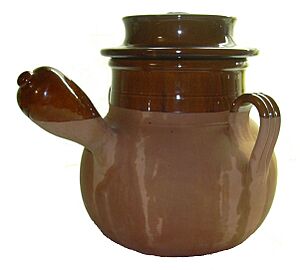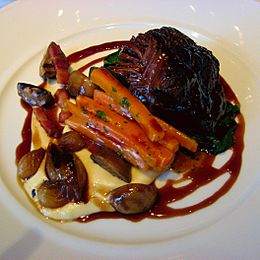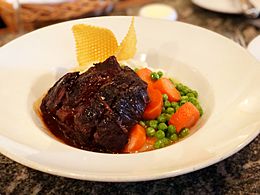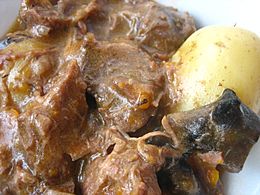Daube facts for kids
 |
|
| Type | Stew |
|---|---|
| Place of origin | France |
| Region or state | Provence |
| Main ingredients | Beef, wine, vegetables, garlic, herbes de Provence |
Daube is a classic French stew. It comes from the Provence region of France. This tasty stew is made with beef, cooked slowly in wine. It also has vegetables, garlic, and special herbs called herbes de Provence.
Traditionally, daube is cooked in a special pot. This pot is called a daubière. It's a terracotta pot that looks a bit like a pitcher. It has a special lid that helps keep moisture inside. This long, slow cooking makes the meat very tender. The beef used often comes from the shoulder or back of the animal. While most recipes use red wine, some older ones used white wine.
Daube has been adapted in other places too. For example, in New Orleans, USA, there's a dish called daube glacé.
Different Kinds of Daube
You can find many different versions of daube. Some recipes add olives or prunes. Others might use duck fat, vinegar, or brandy for extra flavor. Spices like lavender, nutmeg, cinnamon, cloves, or juniper berries can also be added. Sometimes, even orange peel is used.
For the best taste, daube is often cooked in stages. It is cooled for a day after each stage. This allows all the flavors to mix together really well. In some parts of France, like the Camargue region, bull meat is sometimes used for daube.
Traditionally, daube is cooked for a long time. It is often prepared the night before it is served. If daube is made with lamb, it usually uses white wine.
The Daubière Pot
A daube is traditionally made in a special pot called a daubière. This pot is made of earthenware. It has a round, pot-bellied shape. It also has a small opening and a unique lid. The lid has a channel where you can pour water.
Here's how it works:
- The pot is filled with ingredients.
- It is placed over coals or on a stove.
- Water is poured into the channel on the lid.
- The contents cook slowly.
- The clay pot helps keep the food from drying out.
- The water in the lid keeps the top of the pot from getting too hot. This helps the steam cycle inside.
- This process creates a rich, thick sauce.
A daube is best made in a daubière. The shapes of the pot makes sure condensation builds and no evaporation occurs, so everything stays moist.
—Paula Wolfert, The Cooking of Southwest France, 2002, p. 37, ISBN: 0-7645-7602-X
Other Similar Stews
There are other stews that are similar to daube.
- The daube gardiane from the Camargue region uses bull meat.
- The estouffade de boeuf, also called stufatu, comes from Corsica. Sometimes, macaroni pasta is cooked in it at the end.
- Other regions further north in France also have dishes called daube. For example, the daube charentaise stews a whole piece of meat in white wine.
What these stews have in common is how the cooking liquid is handled. The liquid is usually not thickened with flour or cornstarch. This is different from many stews from northern France, like boeuf bourguignon.
- Examples of daube of beef
See also
 In Spanish: Daube para niños
In Spanish: Daube para niños





